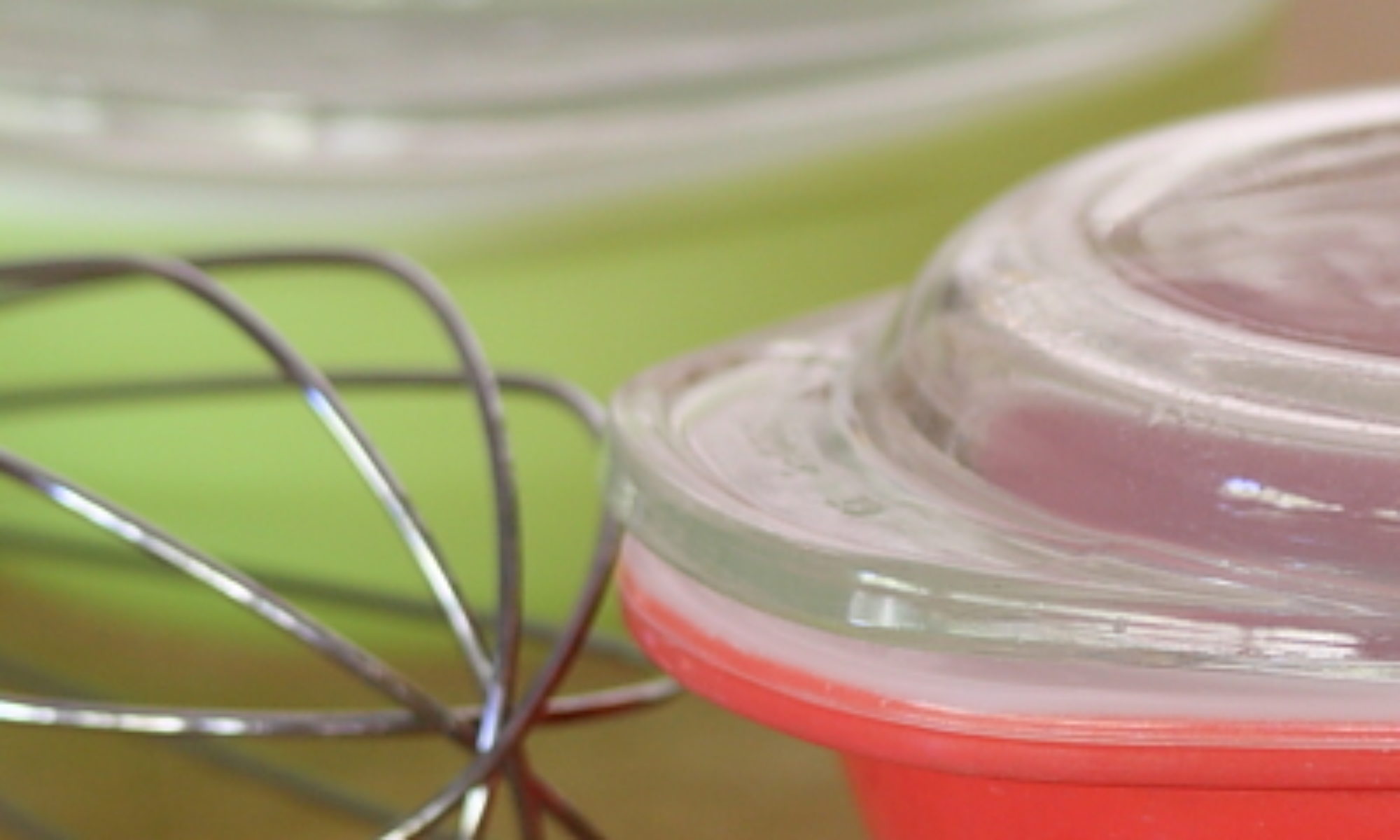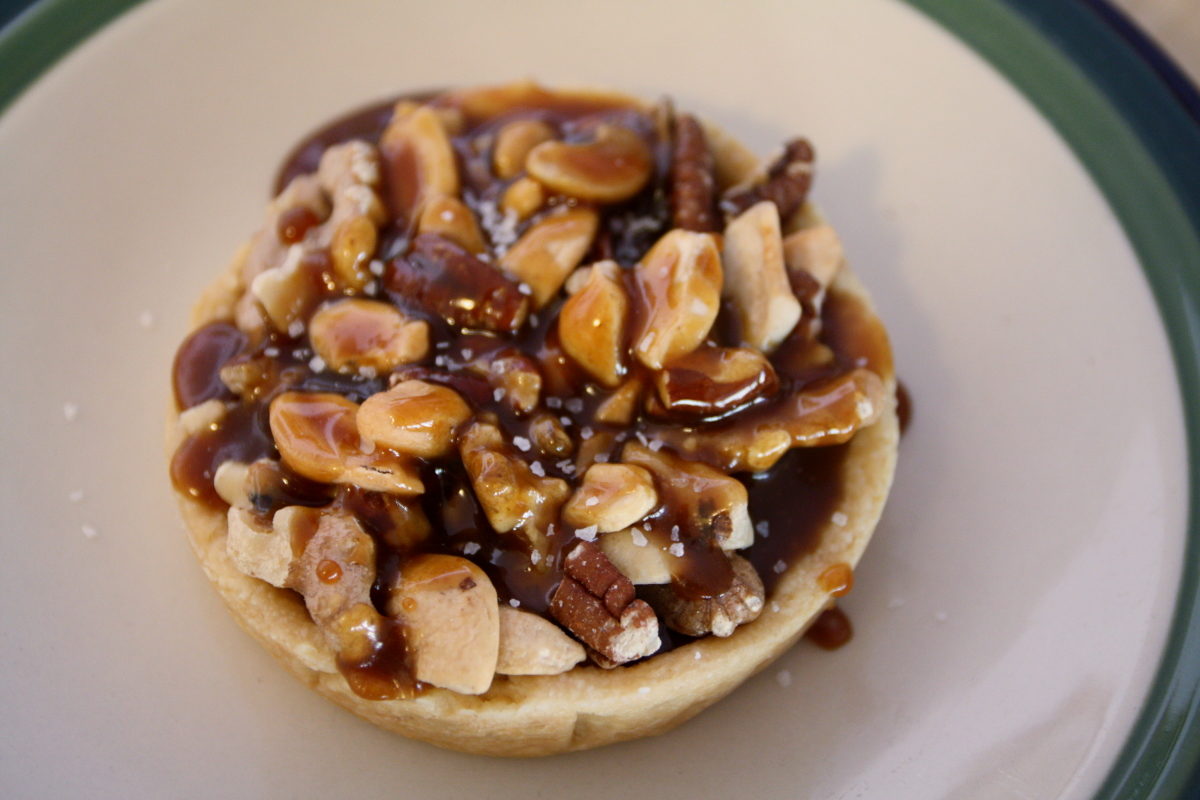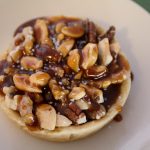
When we looked through the Bouchon Bakery cookbook by Thomas Keller and Sebastian Rouxel, we thought that this looked like one of the easier desserts to create. Simply, three things put together: a crust, roasted nuts, and a caramel sauce, well within our grasp. Yours, too.
Think about that a minute. You can make this tartlet. You, regardless of where you live, can have a dessert that one of the most celebrated chefs in the country would gladly serve (at least, we assume that he would) at his high-end restaurants. There’s nothing tricky here. No magic. Just plain old, everyday scratchin’. Plus, the super-clear instructions from his books (they’re amazing to look through, and give wonderful details of fine cuisine; we give them five stars).
Makes six (3 1/2-inch) tartlets
Caramel Nut Tartlets
Ingredients
- 1 Pâte Brisée chilled and ready to roll see note
- 185 g mixed nuts (1 1/4 cup)
- 170 g corn syrup (1/2 cup)
- 250 g cup sugar (1 1/4 cup)
- 3 Tbs unsalted butter
- 200 g heavy cream (3/4 cup + 1 1/2 Tbs)
- 60 g heavy cream (1/4 cup)
Instructions
- Preheat oven to 325°F. Line a baking sheet with parchment or a silicone baking mat. Place 6 tart rings (3 1/2 inch by 3/4 inch) on the mat.
- Divide pastry dough into 6 pieces. One by one, place between two pieces of parchment and roll out large enough to fill tart ring. Press in and trim away excess dough.
- Pierce the bottom of each tartlet several times with a fork. Freeze for 20 minutes.
- Place nuts on a baking sheet and bake until golden and toasted, 8 to 12 minutes. Set aside to cool completely.
- Remove tartlets from freezer and bake until golden brown, about 35 minutes. Let cool completely, then remove rings.
- Place corn syrup in a large heavy-bottomed saucepan over high heat. Bring to a boil. Add sugar in thirds, stirring enough to incorporate. Cook about 3 minutes until sugar is dissolved and temperature is 350°F.
- Reduce heat to medium and quickly stir in butter. Gradually stir in the first portion of cream. Continue to cook, stirring, until temperature is 248°F.
- Remove from heat and stir in remaining cream.
- Fill each tartlet crust with nuts. They'll be quite full. Pour hot caramel sauce over the nuts, trying to coat completely.
- Let each tartlet cool to room temperature, about an hour, before serving.
Notes
Ingredient discussion:
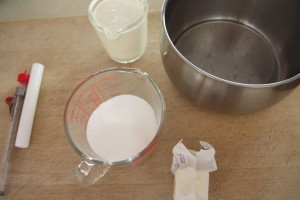
The original recipe called for glucose, instead of corn syrup. We’re not positive, but, searching the Internet, it seems that here in the United States, glucose is corn syrup (or at least close enough). Elsewhere, glucose may be made from things other than corn, so it’s called glucose. Now, we hear people saying they want to use their own pie crust. Sure, you can, but we highly recommend the recipe we give. It’s a breeze to put together, super flaky, and has never failed us. Besides, it’s from the Bouchon Bakery cookbook, too, so your tartlets will be as authentic as possible. For the cream, use a nice, high-quality, heavy cream. We buy the organic version because it doesn’t have seaweed (carrageenan) in it as a thickener.
Oh, and we thought that we’d mention that the original recipe uses a single 8 x 3/4 inch tart ring. We liked the idea of small tartlets, instead.
Procedure in detail:
Preheat oven to 325°F. Line a baking sheet with parchment or a silicone mat and set 6 small tart rings (they look like tuna cans without tops or bottoms) on the sheet.
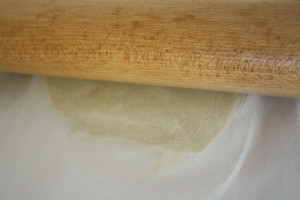
Divide and roll dough. Divide the dough into six equal pieces, and, working one at a time, roll the dough out to a circle about 6 inches in diameter. Place in tart rings and trim off the excess.
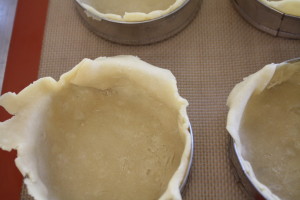
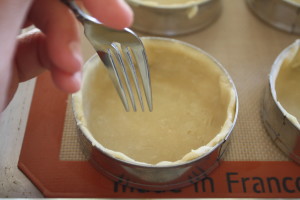
Dock. Poke holes through the bottom of the tart dough with the tines of a fork. We pricked each tartlet about 6 times. This will help to reduce puffing while we blind- bake the crusts. If you prefer, you can weight each tartlet crust with a layer of parchment filled with pie weights. We generally don’t; instead, we use the dock and freeze method, which, while not perfect, works pretty well.
Freeze. Place the baking sheet, dough, tart rings, and all, right into the freezer for 20 minutes. This will also help keep the crust from puffing up in spots. This crust is more likely to puff than some we’ve worked with, but the freezing should do the trick.
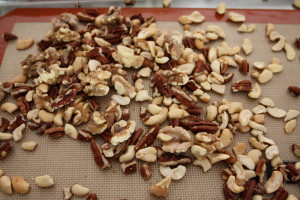
Toast nuts. While the crusts are freezing, scatter the nuts on a baking sheet and toast them for 8 to 12 minutes, or until them become fragrant and golden. Watch like a hawk so they don’t burn. Remove from the oven and let cool.
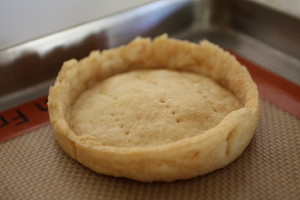
Bake crusts. Slide the frozen tart crusts into the oven and bake 30 to 35 minutes, or until golden brown, rotating the pan halfway through. The crust may pull away from the rings and seem to slump a bit, but it should still be okay. When golden brown, remove from the oven, and let cool completely before removing tart rings and filling with the toasted nuts.
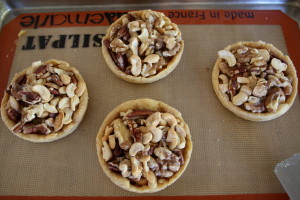
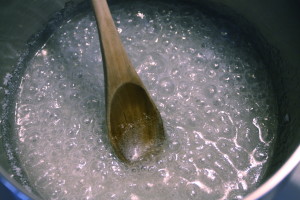
Boil syrup. In a large, heavy-bottomed saucepan, place the corn syrup over high heat and bring to a boil.
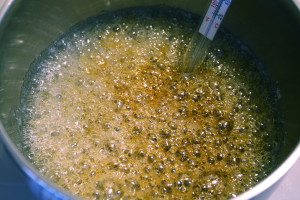
Add sugar. Pour in a third of the sugar, stir just enough to incorporate, add another third of the sugar, stir, then add the last third of the sugar, and stir to incorporate. Insert a candy thermometer and bring back to a boil. Let cook, without stirring, until the mixture is brown and the temperature is 350°F. Yes, that’s not a typo; 350°F. This will take 3 to 5 minutes.
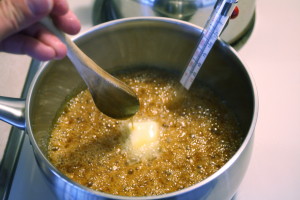
Add butter. Quickly stir in the butter and reduce heat to medium-high. Careful; the butter will spatter a bit when it hits the hot syrup mixture.
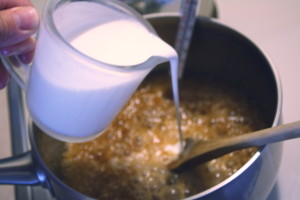
Add cream. Slowly stir in the first portion of cream. This, too, will spatter a bit, and there’s nothing quite like getting a spatter of molten sugar stuck to your hands to remind you to be careful when making confections. So, careful is the watchword.
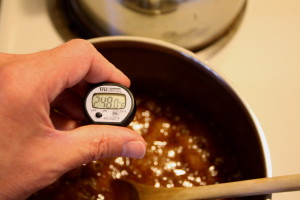
Cook. Stirring continuously, cook the caramel until the temperature is 248°F, about 8 to 12 minutes.

Add remaining cream. Remove from heat and stir in the remaining cream, so you’ll end up with caramel sauce instead of caramels.
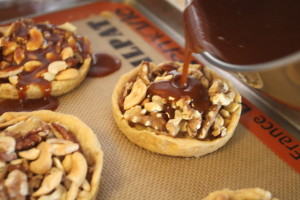
Pour onto tartlets. That’s it! Pour the caramel sauce over the nuts in the tartlet shells. You’ll have about twice as much caramel sauce as you need to fill the shells. The remaining caramel sauce can be used on ice cream later. Or surreptitiously eaten with a spoon. Or even used on another batch of Caramel Nut Tartlets.
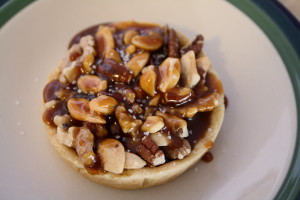
Let cool. Let the caramel sauce in the tartlets cool completely to room temperature before serving, about an hour.
There you go, Caramel Nut Tartlets. Not too hard to make, right? Now, taste them. Delicious. This caramel is not overly sweet, so you don’t feel as if you’re just eating a disk of sugary glop. Instead, this caramel pairs nicely with both the crust and the nuts, allowing the taste of each to come through. One thing that surprised us was that there isn’t any salt in the caramel. Our favorite caramel does have a bit of kosher salt; just 1/4 tsp, mind you, but even that tiny amount really sets it off from other caramels. Because of this concern, we did sprinkle just the tiniest pinch of kosher salt over two of the tartlets to try. We can’t say it was better or worse, just a little different. Either way, this dessert gets five stars.
